35 Flavorful East Asian Pork Dishes Everyone Can Make
East Asian pork dishes represent a culinary journey through rich, complex flavor profiles that tantalize the senses.
Regional cooking techniques transform this versatile protein into mouthwatering masterpieces that reflect centuries of gastronomic tradition.
Generations of home cooks and professional chefs have perfected methods that elevate pork from simple meat to extraordinary cuisine.
Cultural influences weave through each preparation, showcasing intricate marinades, precise seasoning, and innovative cooking approaches that surprise and delight.
Tender, succulent textures emerge from slow-cooking processes that infuse depth and character into every bite.
Aromatic spices and carefully balanced ingredients create harmonious combinations that speak to the sophistication of East Asian culinary arts.
Passionate food lovers appreciate how these dishes balance umami, sweetness, and robust savory notes with remarkable skill.
You'll want to sample all 35 great East Asian pork dishes:
East Asian Pork Dishes Packed with Flavor
Dinner tables in East Asia often feature pork cooked to perfection with regional spices and sauces. Variety and depth of flavor make these recipes true crowd-pleasers.
Samgyeopsal
Sizzling South Korean pork belly samgyeopsal transforms dining into an interactive grilling experience with its succulent three-layered meat strips.
Originating in the 1960s when soju prices dropped, this popular dish became a social staple for Koreans who enjoy it nearly every four days.
Diners grill the fatty meat directly at their table, watching it crisp and caramelize on a specialized pan that drains excess fat.
Thin slices of pork belly cook quickly and develop a rich, crispy exterior.
Accompanying side dishes like kimchi, lettuce wraps, and dipping sauces complement the meat's intense flavor.
Salt and pepper or seasoned salts often enhance the pork's natural richness.
Small dishes of garlic, green onions, and peppers complete this beloved Korean dining tradition.
Bossam
Bossam seduces Korean diners with succulent steamed pork dramatically transformed by wrapping techniques that blend tender meat with crisp vegetable leaves like chard or lettuce.
South Korean restaurants elevate this dish as a perfect companion to alcoholic drinks, serving it with complementary sides such as kimchi stew and seafood pancakes.
Shrimp sauce and sweet kimchi enhance the meat's delicate, creamy flavor profile.
Skilled home cooks carefully steam pork slices to achieve a silky texture that melts in your mouth.
Rice accompanies the dish, providing a neutral base for its complex flavors.
Restaurants across Korea compete to create the most memorable bossam experience.
Diners savor each bite, enjoying the interplay of soft meat and crisp vegetable wrappers.
Jeyuk Bokkeum
Spicy Korean pork stir-fry jeyuk bokkeum bursts with intense flavors from gochujang-based marinade blending chili paste, soy sauce, rice wine, garlic, and ginger.
Thinly sliced fatty pork cuts sizzle when grilled or pan-fried to caramelized perfection.
Korean families frequently prepare this dish at home and restaurants serve it as a popular menu staple.
Diners wrap succulent meat in crisp lettuce or perilla leaves for a hands-on eating experience.
Ssamjang sauce and tangy kimchi complement the spicy protein beautifully.
Marinating techniques ensure deep flavor penetration into each tender meat slice.
Gochujang provides a signature kick that distinguishes this dish from other pork preparations.
Balanced heat and umami make jeyuk bokkeum a crowd-pleasing Korean classic.
Moksal
Moksal emerges as a prized Korean pork cut sourced from the pig's neck, delivering rich marbling and exceptional grilling potential despite its naturally tough texture.
Grillers slice this meat into bite-sized pieces using special scissors during Korean barbecue preparations.
Korean restaurants frequently feature moksal as a premium protein option with less fat compared to traditional samgyeopsal.
Restaurant patrons appreciate its distinctive meaty flavor and tender characteristics when properly cooked.
Restaurants typically serve this cut in pork chop dimensions, ensuring maximum flavor and tenderness.
Korean barbecue menus consistently highlight moksal as a must-try protein selection.
Grilling techniques transform this neck cut into a succulent dining experience that celebrates Korean culinary traditions.
Tonkatsu
Crispy, golden-brown tonkatsu represents Japanese comfort food at its finest, transforming a Western-inspired breaded pork cutlet into a beloved national favorite.
Western cuisine first inspired this dish during Japan's Meiji era, quickly becoming a staple across Japanese restaurants and home kitchens.
Restaurants typically serve tonkatsu with shredded cabbage, sticky rice, and a signature tangy-sweet sauce that complements the meat's rich flavor.
Nagoya-style variations feature miso-drenched cutlets, while other regions experiment with curry-topped or sandwich-style presentations.
Regional adaptations include katsu kare, which combines the cutlet with Japanese curry sauce.
Restaurants serve this dish with traditional side condiments like tonkatsu sauce and pickled vegetables.
Katsudon
Katsudon bursts with Japanese comfort through a crispy breaded pork cutlet nestled atop steaming rice and bathed in a savory egg-based sauce.
Originating in 1921, this classic donburi dish transforms tonkatsu into a soul-warming meal that blends crisp textures with rich umami flavors.
Restaurants across Japan craft unique interpretations by swapping pork with beef or chicken.
Family kitchens embrace this quick, satisfying recipe that combines deep-fried protein with soft eggs and aromatic seasonings.
Street vendors and home cooks celebrate katsudon's simple yet profound flavor profile.
Generations have treasured this balanced one-bowl meal that provides both nutrition and cultural significance.
Japanese diners continue to enjoy katsudon as a quintessential comfort food that connects tradition with modern tastes.
Twice-Cooked Pork (Hui Guo Rou)
Twice cooked pork mesmerizes diners with its bold Sichuan flavors and unique two-stage cooking method that transforms fatty pork into a crispy, caramelized masterpiece.
Originating during China's Song Dynasty, this legendary dish begins by simmering pork leg or belly until tender, then chilling it to firm the meat and fat.
Skilled home cooks slice the cooled meat and stir-fry it with a colorful array of vegetables like cabbage, bell peppers, and mushrooms.
Soy sauce, rice wine, and regional spices create a rich, umami-packed sauce that coats each morsel.
Traditional recipes demand careful attention to achieving perfectly crisp edges and deep brown coloration.
Generations have treasured this iconic dish as a testament to Chinese culinary artistry.
Chinese Bbq Pork (Char Siu)
Succulent char siu transforms barbecued pork into a mouthwatering Cantonese delicacy that tantalizes taste buds with its deep crimson glaze and complex flavor profile.
Ancient Chinese cooks originally crafted this dish using wild game and domesticated pigs roasted on long forks over open flames.
Soy sauce, hoisin, rice wine, and star anise create the signature marinade that caramelizes into a glossy, sweet-savory coating.
Restaurants and street vendors across Hong Kong and southern China serve char siu as both an appetizer and main course.
Sliced or shredded pork appears in countless regional dishes, from rice plates to noodle soups.
Cantonese cuisine celebrates this beloved protein that symbolizes culinary mastery and flavor complexity.
Modern variations include different meat cuts and cooking techniques that honor the dish's rustic origins.
Roast Suckling Pig (Siu Yuk)
Siu yuk stands out as a crispy-skinned Cantonese roasted pork delicacy that transforms an entire pig into a mouthwatering masterpiece through high-temperature charcoal roasting.
Skilled butchers carefully season the meat with salt and spices before slow-roasting it to achieve perfectly crisp exterior and succulent inner layers.
Hong Kong culinary traditions often feature this dish during celebratory events, including movie premieres where it might be offered to the Jade Emperor for good fortune.
Chinese diners typically enjoy small portions of siu yuk, savoring its rich flavors and contrasting textures.
Restaurants across southern China specialize in this technique, perfecting the art of meat preparation.
Hoisin or soy sauce frequently accompanies the dish, enhancing its already complex flavor profile.
Braised Pork Rice (Lu Rou Fan)
Ground pork braised in a rich symphony of soy sauce, five-spice powder, and rice wine transforms lu rou fan into Taiwan's most beloved comfort meal.
Farmers originally crafted this savory dish as a nutritious staple that quickly became a national culinary treasure.
Families often enjoy lu rou fan with pickled cucumbers or shiitake mushrooms for added texture and flavor.
Some restaurants swap traditional rice for noodles, offering a creative twist on the classic preparation.
Taiwanese ragu, as it's sometimes called, carries deep cultural significance beyond simple sustenance.
Its complex flavor profile reflects generations of cooking wisdom passed through family traditions.
Simmered slowly, the ground pork absorbs layers of umami that make each bite a comforting experience.
Sweet And Sour Spare Ribs (Tang Cu Pai Gu)
Mouthwatering sweet and sour spare ribs represent a quintessential Chinese delicacy celebrated for its complex flavor profile and cultural significance.
Southern Chinese regions pioneered this crispy pork dish that symbolizes prosperity during festive celebrations.
Cooks carefully marinate tender spare ribs before deep-frying them to achieve a perfectly golden exterior.
Tangy sweet and sour sauce coats the meat, creating a balanced blend of crispy texture and zesty flavor.
Chinese New Year festivities frequently feature this dish, as the Cantonese pronunciation of "sour" sounds similar to "grandchild," signifying hope for family growth.
Restaurant menus across China showcase this appetizer, which requires specialized cooking techniques challenging for home preparation.
Pork's symbolic importance in Chinese culture further elevates the dish's traditional meaning.
Dongpo Pork (Dongpo Rou)
Dongpo rou emerges as a legendary Chinese delicacy featuring meltingly soft pork belly bathed in a rich, glossy sauce that honors its namesake Su Dongpo, an 11th-century renaissance man who accidentally perfected this dish during an intense chess match.
Shaoxing rice wine and soy sauce form the core flavor profile of this iconic Hangzhou specialty, transforming ordinary pork into a luxurious culinary masterpiece.
Meticulous preparation involves browning meat with skin intact, then simmering, braising, and steaming until chopsticks can effortlessly pull apart each succulent morsel.
Su Dongpo's culinary mishap became a gastronomic sensation, blending his artistic sensibilities with extraordinary cooking techniques.
Traditional ingredients like ginger and scallions enhance the complex flavor spectrum of this historic dish.
Slow-cooking methods guarantee an incredibly tender texture that defines Dongpo rou's reputation.
Butadon
Butadon bursts with savory flavors, combining succulent fatty pork slices atop steaming white rice in a classic Japanese comfort meal.
Originating in Hokkaido, this simple yet satisfying dish showcases tender pork simmered in a rich, slightly sweet soy-based sauce.
Japanese home cooks traditionally prepare the meat with carefully caramelized edges, creating a perfect balance of umami and sweetness.
Green peas and sliced onions frequently accompany the meat, adding color and subtle texture to the bowl.
Restaurants across Japan serve butadon as a quick, affordable lunch option that fills you up quickly.
Street vendors and family restaurants pride themselves on perfecting this straightforward recipe.
Butadon literally translates to "pork bowl" in Japanese, reflecting its uncomplicated yet delicious nature.
Ogyeopsal
South Korean barbecue reaches peak deliciousness with ogyeopsal, a premium pork belly cut featuring skin that elevates grilling to an art form.
Sliced into thin strips, this succulent meat sizzles on hot grills with an irresistible aroma that draws diners closer.
Korean restaurants and home cooks carefully prepare ogyeopsal by grilling it until edges become crispy and golden brown.
Diners typically wrap the meat in lettuce leaves with accompanying side dishes like kimchi and garlic.
Distinct from samgyeopsal, this cut includes the skin, which adds extra richness and texture to each bite.
Restaurants often serve the meat with dipping sauces that complement its natural flavors.
Seasonings like salt, pepper, and sesame oil enhance the pork's inherent taste.
Fresh herbs and vegetables provide a refreshing contrast to the meat's intense umami profile.
Chashu
Chashu delivers melt-in-your-mouth pork belly that captures the essence of Japanese comfort food through slow braising in a rich soy sauce, sake, and mirin blend.
Originating from Chinese char siu, this dish transforms ordinary pork into a tender masterpiece with complex flavor layers.
Rolled or flat pork belly absorbs the fragrant marinade during hours of gentle cooking.
Ginger and scallions enhance the sauce's depth, creating an aromatic infusion.
Sugar caramelizes the skin, developing a slightly gelatinous texture that adds complexity.
Each slice promises incredible softness and juiciness from the meticulous cooking process.
Sake and soy sauce work together to tenderize the meat completely.
Braised Pork Belly (Hong Shao Rou)
Succulent pork belly braised in a glossy, caramelized sauce defines hong shao rou, a beloved Chinese classic that tantalizes taste buds with its rich, sweet-savory profile.
Originating from Hunan province and popularized in Shanghai, this iconic dish gained fame as Chairman Mao's favorite comfort food.
Generations of families have cherished their unique recipes, often incorporating hard-boiled eggs, tofu puffs, or aromatic spices like star anise.
Tender pork belly slowly simmers in a luxurious blend of rice wine, sugar, and soy sauce, creating a vibrant red sauce that transforms humble ingredients into a culinary masterpiece.
Cultural significance runs deep, with hong shao rou serving both everyday meals and special celebrations.
Peking Shredded Pork (Jing Jiang Rou Si)
Beijing's jing jiang rou si stands out as a delectable street food masterpiece featuring tender pork slices simmered in sweet bean sauce and carefully wrapped in thin pancakes.
Restaurants across China prepare this iconic northern dish with razor-sharp knife skills, slicing pork into precise, uniform strips.
Authentic versions highlight crispy-edged meat caramelized in a rich, dark sauce made from fermented soybean paste.
Casual dining spots and home kitchens celebrate this street-friendly meal that balances sweet and savory flavors.
Travelers seeking genuine Beijing cuisine often prioritize this classic street food experience.
Beijing locals consider jing jiang rou si a proud culinary symbol of their metropolitan cooking traditions.
Meat quality and sauce complexity determine the dish's ultimate success and flavor profile.
Jokbal
Mouthwatering South Korean jokbal transforms pig's legs into a savory street food sensation with its tender, succulent meat slow-cooked in a complex blend of soy sauce, ginger, and sweet black taffy.
Restaurants across Seoul serve this signature dish alongside crisp kimchi, zesty buchu, and tangy shredded radish for maximum flavor contrast.
Diners wrap the juicy meat in lettuce leaves and slather on ssamjang, a spicy fermented bean paste that elevates every bite.
Koreans consider jokbal a social meal perfect for sharing with friends after work or during late-night gatherings.
Street vendors and restaurants pride themselves on perfecting this traditional preparation method that tenderizes tough meat cuts.
Simmering the pig's legs for hours creates an incredibly soft texture that melts in your mouth.
Ssamjang's bold flavors complement the rich, gelatinous meat with its sharp pepper and fermented undertones.
Kakuni
Kakuni stands out as a mouthwatering Japanese comfort food featuring tender pork belly slow-braised in a rich, sweet-savory sauce that melts in your mouth.
Originating from Nagasaki, this classic dish transforms humble ingredients into a luxurious meal through patient simmering techniques.
Thick cuts of pork belly absorb layers of flavor from traditional seasonings like soy sauce, sake, mirin, and dashi.
Gentle cooking breaks down tough meat fibers, creating an incredibly soft texture that practically dissolves on your tongue.
Sugar adds a subtle sweetness that balances the umami-packed broth, making each bite deeply satisfying.
Restaurants and home cooks often serve kakuni over steamed rice, garnishing it with green onions or boiled eggs.
Japanese families treasure this dish as a nostalgic reminder of home-cooked warmth and culinary tradition.
Generations have passed down this recipe, celebrating its simple yet profound ability to comfort and nourish.
Chinese Hamburger (Rou Jia Mo)
Shaanxi province's famous street food, rou jia mo, delivers a mouthwatering Chinese-style sandwich packed with intense flavor combinations.
Crispy flatbread called bai ji mo cradles succulent braised pork belly seasoned with a complex blend of over 20 spices.
Ginger, hot peppers, onions, sugar, soy sauce, and Shaoxing wine transform the meat into a rich, tender filling that melts in your mouth.
Street vendors carefully craft each sandwich by hand, ensuring maximum flavor in every bite.
Historically connected to Xi'an's culinary traditions, rou jia mo represents a perfect balance of texture and spice.
Ancient recipes passed through generations continue to delight hungry diners across China.
Shogayaki
Sizzling Japanese pork slices soaked in a punchy ginger-soy sauce blend define shogayaki, a beloved national comfort meal that transforms simple ingredients into an explosion of flavor.
Lean cuts get thinly sliced and quickly braised in a zesty marinade of soy sauce, mirin, and freshly grated ginger.
Families and restaurants across Japan regularly serve this protein-packed dish as a satisfying lunch or dinner option.
Small side dishes like steamed rice and pickled vegetables typically accompany the savory meat.
Ginger plays a crucial role in creating the dish's signature tangy undertone.
Rafute
Rafute emerges as Okinawa's signature pork belly delicacy, slowly braised in a rich blend of black sugar, soy sauce, and awamori until meat becomes meltingly tender.
Generations of Okinawan families have perfected this succulent dish through careful preparation techniques passed down through decades.
Restaurants across Japan's southern islands offer unique interpretations of this classic recipe, each adding personal touches to the traditional method.
Fatty pork transforms into a deeply caramelized masterpiece during long, slow cooking processes that break down tough muscle fibers.
Black sugar provides a distinctive sweetness that balances the intense umami of soy sauce and the sharp undertones of awamori liquor.
Soft, fall-apart meat practically dissolves on the tongue, creating an unforgettable dining experience.
Hanjeongsal
Korean barbecue lovers prize hangjungsal as a rare, prized pork jowl cut that delivers intense marbling and rich flavor from the pig's cheek muscle.
Butchers carefully extract this premium meat, which weighs approximately 200 grams per whole pig, making it significantly more scarce than common cuts like samgyeopsal and moksal.
Grilling transforms the meat's intricate fat layers into crispy, caramelized edges that melt in your mouth with incredible succulence.
Korean restaurants often serve hangjungsal with traditional banchan side dishes and tangy dipping sauces to complement its robust taste.
Diners typically grill the meat themselves at the table, creating an interactive dining experience that celebrates the cut's unique texture.
Restaurants carefully slice the meat thin to ensure even cooking and maximum flavor absorption.
Salt and pepper season the meat simply, allowing its natural richness to shine through.
Sweet And Sour Pork (Gu Lao Rou)
Sweet and sour pork explodes with crispy battered pork chunks bathed in a tangy red sauce that originated in Cantonese cuisine during the 18th century.
Chinese immigrants introduced this flavor-packed dish to the United States in the early 1900s while working on railroad construction.
Restaurants quickly embraced the recipe, featuring golden-brown meat pieces coated in a glossy, zesty sauce.
Carrots, green peppers, and onions add crunch and color to the vibrant plate.
Deep-frying transforms the pork into a perfectly crisp exterior while maintaining a juicy interior.
Balancing sweet and sour elements creates an irresistible flavor profile that has captivated diners for generations.
Cantonese chefs mastered this technique, ensuring each bite delivers maximum taste and texture.
Restaurants worldwide now serve this iconic Chinese-American fusion dish that continues to delight hungry guests.
Dwaeji Galbi
Korean pork ribs sizzle with intense flavors and tender meat that melts in your mouth, making them a standout barbecue dish prized across Korea.
Gochujang's spicy-sweet chili paste transforms ordinary ribs into a culinary masterpiece with deep, complex marinades.
Careful preparation involves coating meat with rice wine, garlic, and ginger for maximum tenderness and rich taste.
Traditional grilling techniques ensure each rib develops a perfectly caramelized exterior while maintaining juicy inner meat.
Marinating techniques vary between spicy gochujang-based blends and milder soy sauce versions, allowing diverse flavor profiles.
Korean families often gather around grills, sharing these succulent ribs during social meals and celebrations.
Restaurants and street vendors throughout Korea continue to perfect this beloved meat dish that connects generations through incredible taste.
Pork Chop Bun
Macanese pork chop bun stands as a mouthwatering street food masterpiece blending Portuguese and Asian culinary traditions into one irresistible sandwich.
Portuguese colonial influence sparked this simple yet genius creation featuring a crispy-crusted piggy bun from Hong Kong cradling a perfectly seasoned grilled pork chop.
Macau's signature street snack emerged from cultural crossroads where European and Asian flavors naturally collide.
Minimal ingredients - just bread and meat - make this handheld treat remarkably satisfying and unpretentious.
Crispy exterior and soft interior of the bun provide textural contrast against the juicy, well-seasoned pork chop.
Street vendors throughout Macau serve this iconic dish, which has become a beloved regional staple.
Galmaegisal
Galmaegisal sizzles as a prized Korean barbecue delicacy featuring skirt meat sliced from a pig's diaphragm, known for its uniquely chewy texture and intense flavor profile.
Korean grillmasters carefully slice the meat into thin strips before expertly cooking it over hot flames.
Restaurants traditionally serve this cut with accompanying side dishes like kimchi and fresh vegetables.
Salt and pepper often season the meat, enhancing its natural richness.
Diners typically wrap the grilled strips in lettuce leaves with garlic and other condiments.
Molecular structure makes this cut tougher than standard pork selections.
Regional Korean barbecue restaurants consider galmaegisal a specialty item.
Moo Shu Pork (Mu Xu Rou)
Moo shu pork blends savory pork tenderloin with a symphony of vegetables and mushrooms in a tantalizing Northern Chinese stir-fry that conquered American-Chinese menus.
Tender meat sizzles with crisp cucumbers and scrambled eggs, dancing in peanut or sesame oil alongside delicate day lily buds and earthy wood ear mushrooms.
Minced ginger, garlic, and scallions infuse the dish with bold, aromatic flavors, while soy sauce and rice wine add depth and complexity.
Multiple theories swirl around its mysterious origins, though most trace roots to the Shangdou province.
Variations like moo shu lu feature gravy and often include soft tofu and noodles.
United States restaurants embraced the dish in the 1960s, adapting ingredients to local tastes.
Typically served with rice, this stir-fry offers a perfect balance of textures and tastes.
Steamed Spare Ribs (Pai Gwut)
Steamed black bean pork ribs emerge as a mouthwatering Cantonese dim sum classic that tantalizes taste buds with intense umami flavors.
Fragrant black beans infuse tender pork rib tips with rich, savory depth during quick steaming.
Ginger and garlic provide sharp aromatic undertones that complement the meat's natural richness.
Subtle rice wine adds gentle complexity to the dish's flavor profile.
Cornstarch helps tenderize the meat while creating a silky texture.
Sesame oil brings a nutty finish to each succulent bite.
Pepper and sugar balance the sauce's salty notes with subtle warmth.
Cantonese restaurants across Hong Kong serve this beloved small plate as a staple dim sum selection.
Goya Chanpuru
Goya chanpuru bursts with Okinawan culinary boldness, featuring bitter melon's intense flavor as its signature ingredient in a sizzling stir-fry.
Originating from Japan's southern islands, this robust dish combines crisp tofu, tender pork, and farm-fresh eggs in a quick-cooked medley.
Bitter melon's sharp taste dominates the plate, balancing protein and vegetable textures with remarkable complexity.
Skilled home cooks carefully slice the green gourd into thin rings, ensuring maximum flavor absorption.
Seasonings like soy sauce and mirin enhance the dish's umami profile, creating depth beyond simple ingredients.
Restaurants across Okinawa serve this classic comfort food with steamed white rice.
Generations have cherished goya chanpuru as a quintessential example of regional Japanese home cooking.
Lychee Pork (Lizhi Rou)
Lychee pork orlizhi rouis tantalizes taste buds with its ingenious fusion of sweet and savory flavors from Fujian's culinary landscape.
Crispy golden-brown pork cubes dance alongside juicy lychee fruits in a vibrant sauce that balances soy sauce, rice vinegar, and rice wine.
Chefs carefully tenderize and dredge pork pieces in cornflour before deep-frying them to perfection.
Scallions add a subtle green crunch to the dish's dynamic profile.
Ingredients like vegetable oil and salt enhance the overall flavor complexity.
Master cooks prepare this dish as a testament to Fujian's rich gastronomic heritage.
Daeji Galbi
Korean daeji galbi transforms grilled pork ribs into a sensational street-style feast that sizzles with bold flavors and cultural authenticity.
Marinated in a powerful blend of gochujang, soy sauce, garlic, and ginger, these tender ribs promise an explosive taste experience that dances between sweet and spicy.
Restaurants and home cooks typically grill the meat over high heat, creating crispy caramelized edges that seal in rich, juicy flavors.
Sesame oil and black pepper add depth to the marinade, enhancing the pork's natural richness.
Traditional Korean barbecue techniques ensure each bite delivers maximum umami and charred goodness.
Ginger and onions contribute aromatic complexity to the dish's layered taste profile.
Sugar in the marinade helps create a glossy, caramelized exterior that makes these ribs irresistibly appetizing.
Wuxi Pork Ribs (Wu Xi Rou Gu Tou)
Wu xi rou gu tou packs a punch of Jiangsu province's most beloved braised pork rib specialty, featuring succulent meat slowly simmered in a complex blend of aromatic spices.
Chinese culinary masters meticulously prepare these tender ribs by cutting premium pork into generous squares and seasoning them with salt before gentle boiling.
Shaoxing wine, star anise, and cinnamon infuse deep, rich flavors into the meat during careful braising.
Scallions and ginger contribute bright, sharp notes that balance the rich protein.
Soy sauce and sugar create a glossy, caramelized coating that makes each bite irresistible.
Traditional clay pot cooking ensures even heat distribution and maximum flavor absorption.
Regional techniques passed through generations guarantee authentic preparation.
Soft, melt-in-your-mouth meat emerges as the ultimate reward for patient cooking.
Stir-Fried Celery With Minced Pork (Lanrou Xiqin)
Lanrou xiqin bursts with Sichuan's spicy soul, transforming simple ingredients into a fiery masterpiece of ground pork, celery, and chili-infused complexity.
Doubanjiang provides the dish's signature intense heat, creating a deep red color that signals its bold flavor profile.
Sichuan pepper adds a unique numbing sensation that dances across your palate, while Chinkiang vinegar balances the richness with sharp tanginess.
Ginger and chili oil contribute layers of aromatic warmth that elevate the dish's depth.
Stir-frying ground pork in hot oil begins the cooking process, ensuring crisp texture and caramelized edges.
Soy sauce introduces a savory undertone that anchors the dish's robust character.
Finely chopped celery provides a fresh, crisp contrast to the intense spiciness.
Koe-A Bah
Koe-a bah bursts with Taiwanese street food magic, featuring ground pork nestled with tangy pickled cucumbers in a flavor-packed steamed creation.
Browned shallots add depth to the savory mixture, while rice wine and soy sauce paste amplify the dish's complex profile.
Ginger and white pepper contribute warming spice notes that dance across your palate.
Star anise introduces subtle licorice undertones that complement the meat's richness.
Traditional seasonings like sugar balance the intense umami flavors with gentle sweetness.
Garlic provides an aromatic punch that elevates every bite.
Taiwanese home cooks often serve this dish as a comforting meal with steamed rice, celebrating the simple yet profound ingredients.
What Ingredients Give East Asian Pork Dishes Their Rich and Distinctive Flavors?
East Asian pork dishes are famous for their vibrant, well-balanced flavors, thanks to a combination of key ingredients that work together beautifully. Here’s a closer look at what makes these dishes so flavorful, with examples to inspire your cooking:


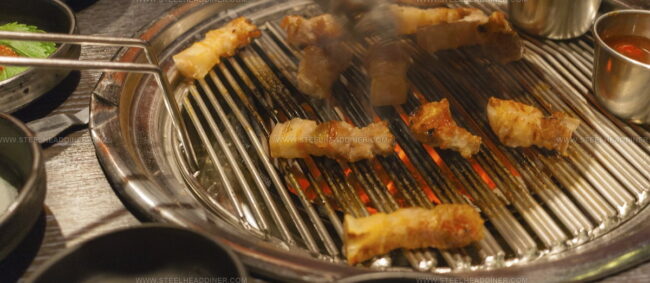
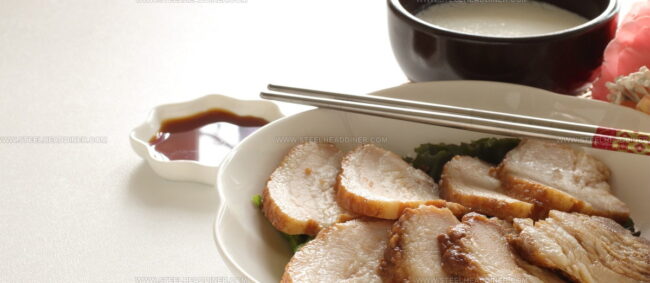
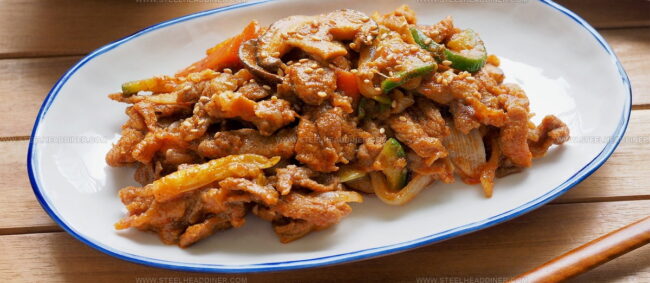
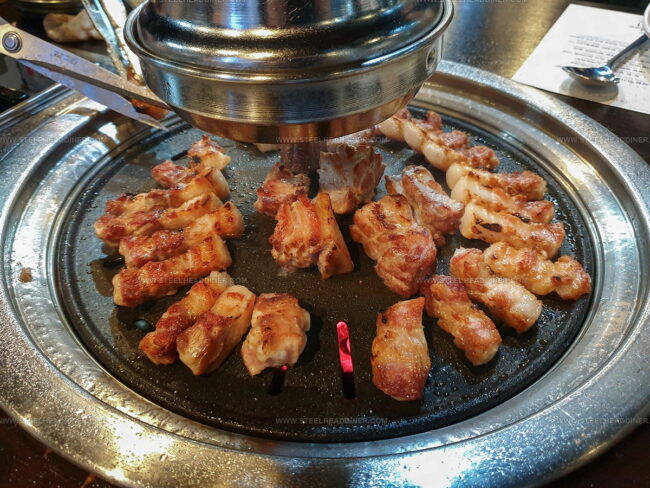

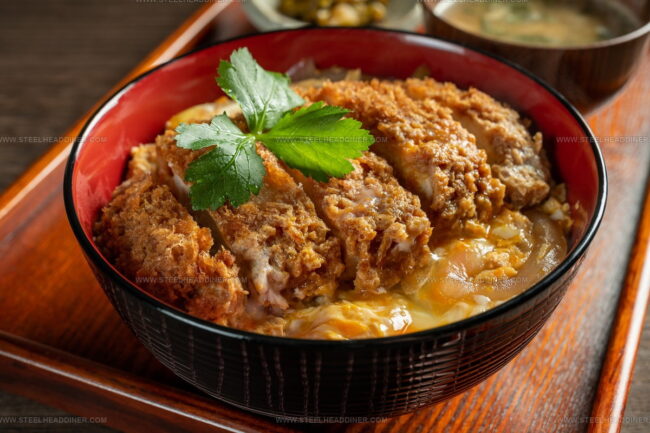
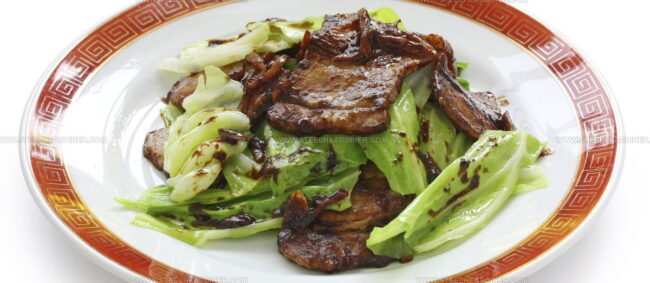

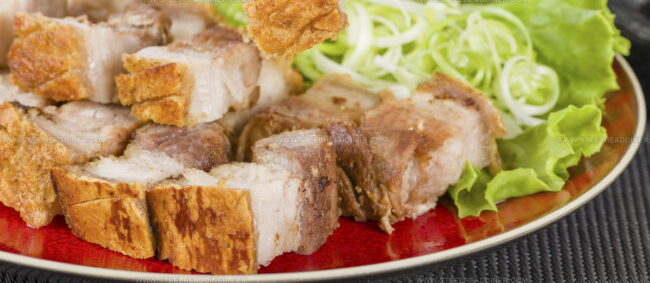


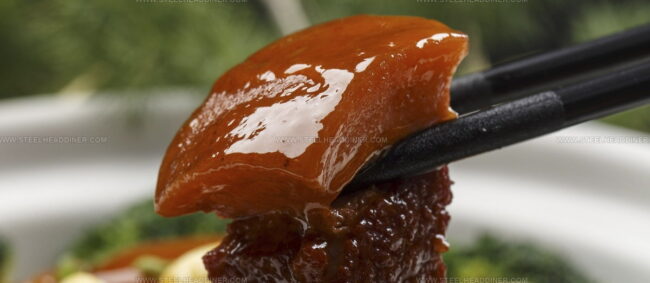

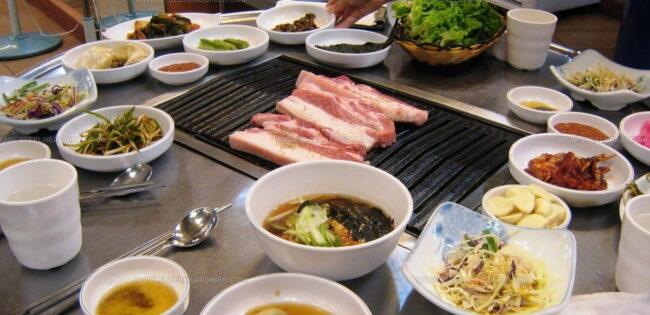
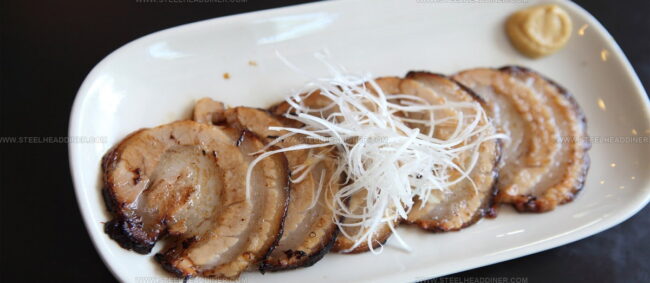
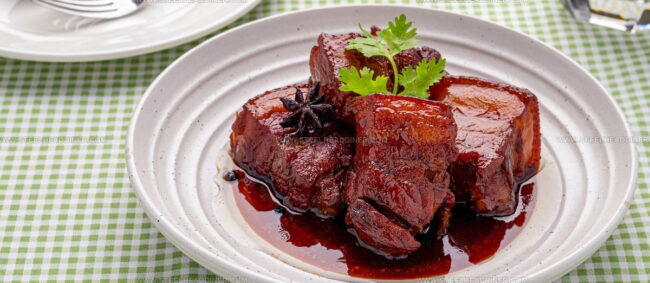
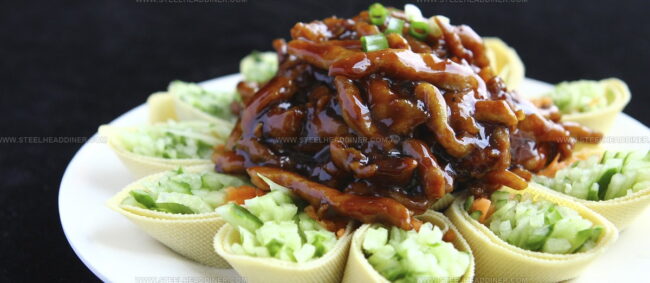
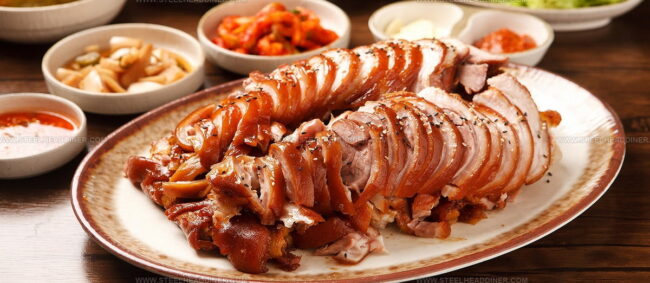
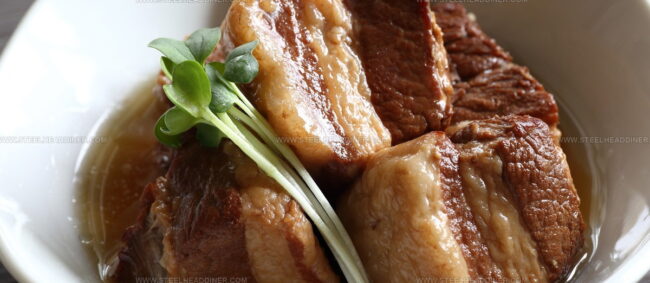

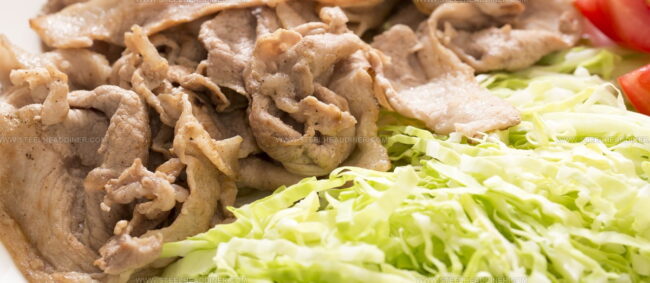
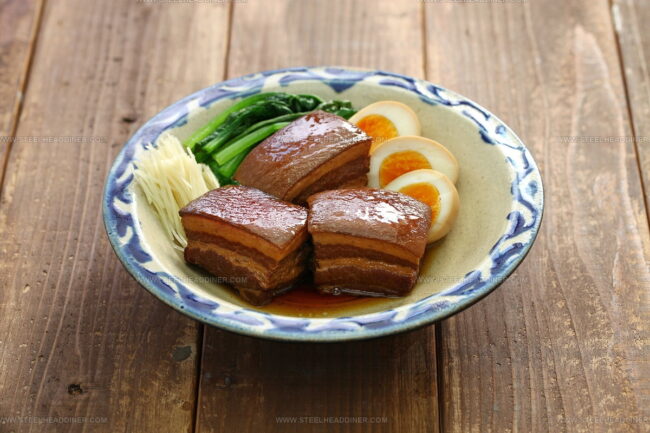
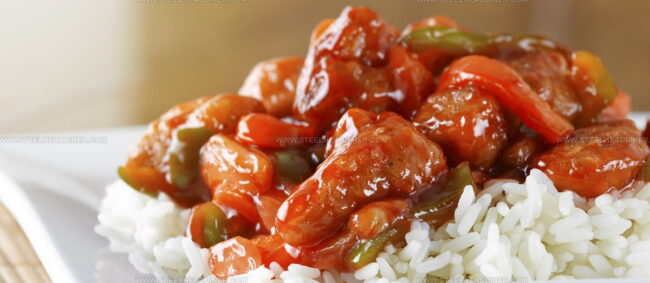
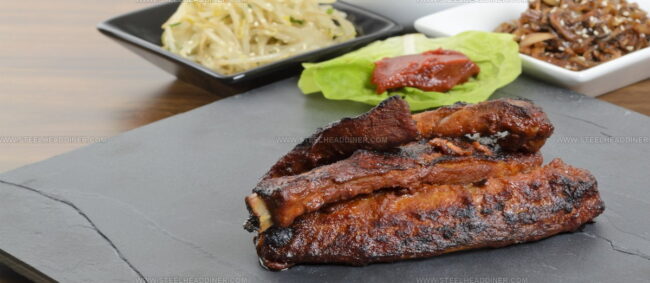

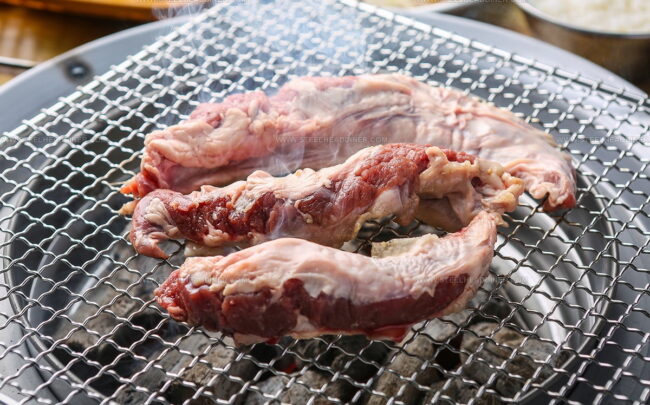

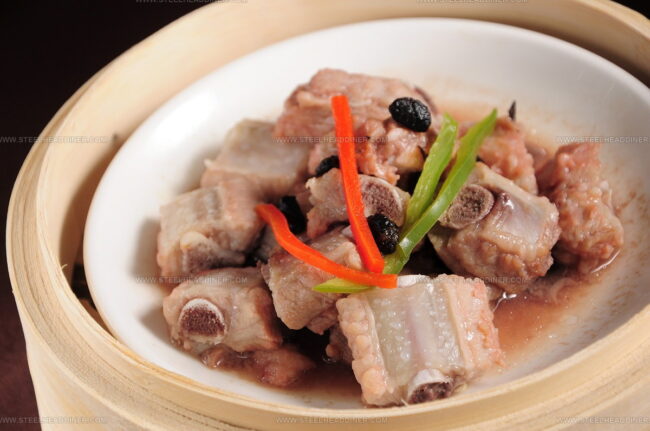

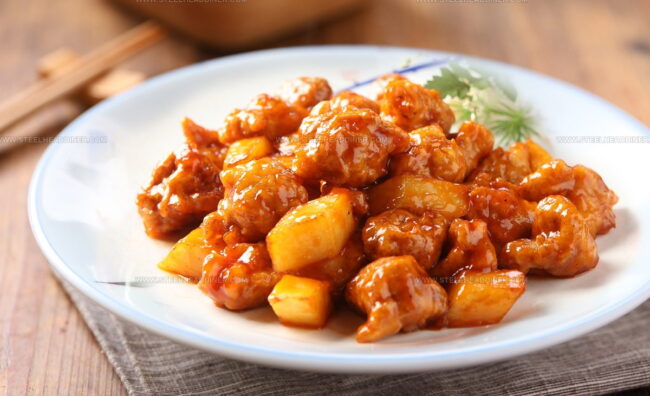
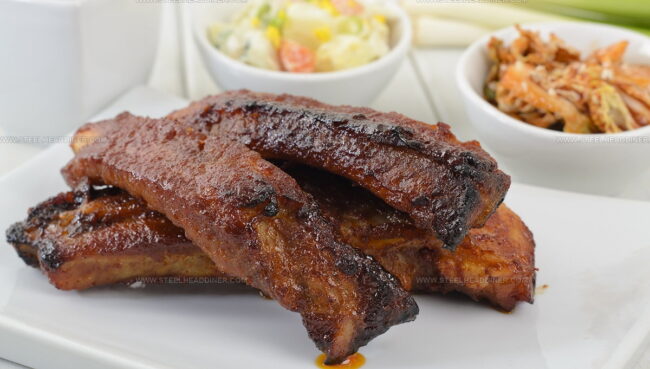
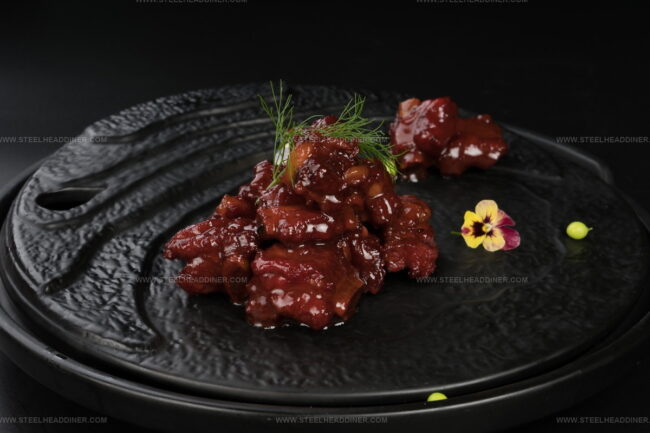
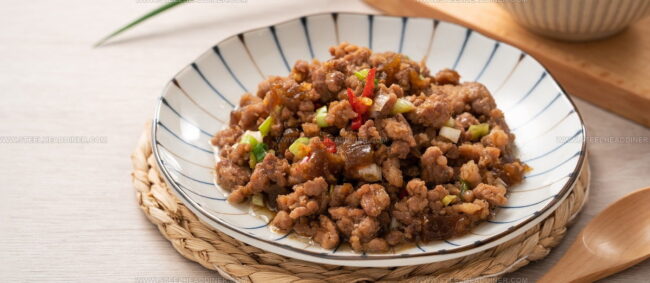
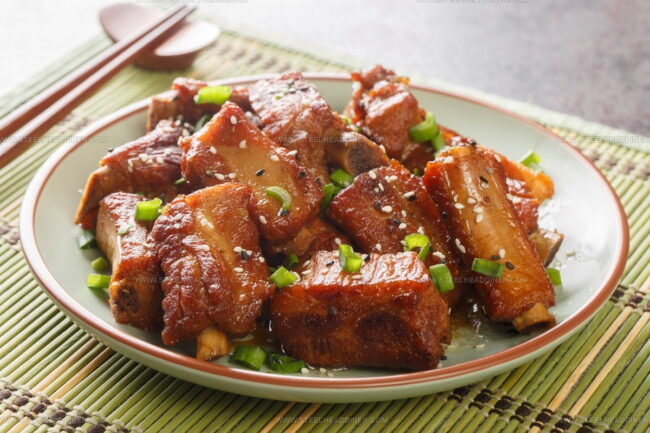
Jack Monroe
Founder & Recipe Innovator
Expertise
Pacific Northwest cuisine, Single-serving recipe development, Sustainable sourcing and cooking, Modern comfort food
Education
Brightwater
Associate of Applied Science in Culinary Arts
Focus: Sustainable cooking, seasonal ingredients, and food systems education
Jack grew up with a fishing rod in one hand and a cast-iron skillet in the other. After graduating from Brightwater: A Center for the Study of Food, he set out to prove that cooking for one could still taste like a feast.
Jack believes that food should feel real: fresh, fearless, and a little wild, just like the rivers he grew up around. For Jack, every single dish is a small adventure, and the best ones are the ones you can cook with heart, not hassle.